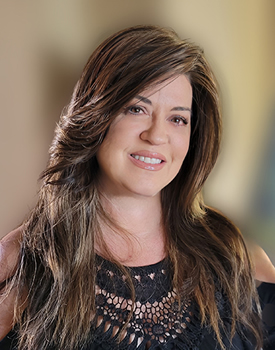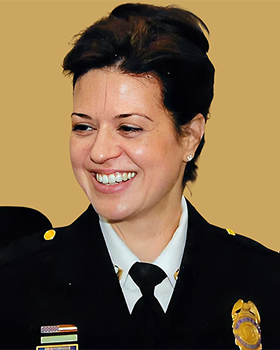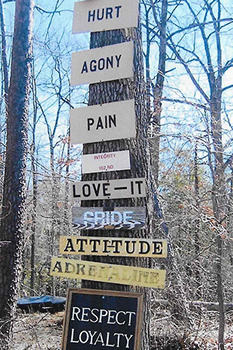

Features Up Close: Isabella Maldonado
Trailblazing for Latinx Heroes in an Escape Room Gone Rogue
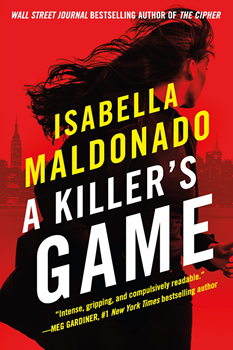 By K.L. Romo
By K.L. Romo
In her newest thriller, A KILLER’S GAME, bestselling author Isabella Maldonado inserts her Latina hero, Dani Vega, into a mythological virtual odyssey, plunges it inside an escape room, then wraps it all in a thriller.
Vega is a former code breaker for the US Army Rangers. Now an FBI agent, she’s an expert in cryptanalysis and pattern recognition. When Vega witnesses the unusual murder of a US senator’s chief of staff in NYC, she chases the assailant but loses him. But with the help of thousands of Transit Authority cameras, they make an ID.
The suspect is a known assassin, Gustavo Toro, and Vega suspects something nefarious is behind the killing, but nothing about the case fits a pattern. The only way to find out is to infiltrate the underground group that organized the hit while working with Toro.
Once Vega and Toro are taken to a secret below-ground facility, it’s apparent they’re part of a killing game that’s both virtual and real, in a mega seven-story escape room manipulated by an unknown puppeteer. He calls the game “trial by combat.” But trial for what? Vega must use all her logic puzzle and code skills to survive.
Here, Maldonado chats with The Big Thrill about how critical it is to read about a character who looks like you, her love of logic puzzles, and her mastery of the FBI’s “yellow brick road.”
What was the impetus for the story in A KILLER’S GAME?
I’ve noticed an explosion in the popularity of escape rooms. People all over the world are discovering the thrill of solving puzzles, riddles, and clues while a clock ticks down. When my teenage son went to one last year, I got to thinking: what if someone diabolical created a real escape room with deadly consequences? My imagination took over.
Why was it important to you to create strong Latinx female protagonists, even when you were advised that a novel with people of color as the heroes wouldn’t sell? And how do you stay true to your story, especially if you receive criticism?
Several years ago, I’d finished a manuscript and was in search of representation when I scored a one-on-one meeting with a well-known and established literary agent. After looking over my material, his opening comment was, “if you tell anyone I said this, I’ll deny it.” I braced myself for the worst…which is what I got.
He informed me I write very well, and he’d love to represent me, but I needed to change my main character to a white person. “Everyone gives lip service to diversity,” he went on, “but whenever I’ve tried to sell it, no one’s buying.” He gave his head a rueful shake. “With a few exceptions, there’s just no market for diverse characters…unless they’re in a supporting role.”
I believe heroes are found in all cultures and that it’s essential to tell stories from all perspectives, so I ignored his advice and continued to center my books around strong Latinx characters. I also found an agent who believed in me, embraced my main characters, and loved their complicated and twisty stories. She’s negotiated several contracts with an outstanding publisher, and it turns out there is a market for diverse main characters. My novels have hit bestseller lists, found a worldwide readership, and are now published in 23 languages.
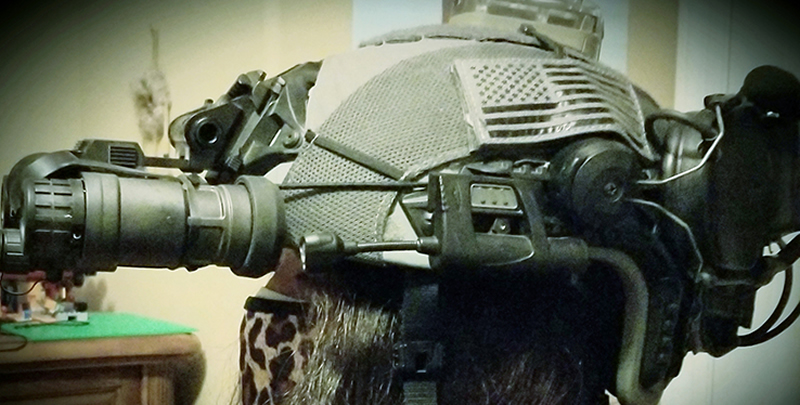
Isabella wearing tactical headgear and full night vision equipment (she did it when researching a scene in a novel that required night vision)
As a law enforcement officer, one of your specialties was forensics. Of course, every crime presents a puzzle to be solved, but did you ever have to use special cryptography skills to flesh out the clues?
While I commanded my department’s Special Investigations and Forensics Division, I was never a cryptographer. Instead, I used good old deductive reasoning, basic psychology, and whatever knowledge I’d gleaned about human nature from years on the job to flesh out the clues.
Have you been to an escape room? Do you enjoy solving puzzles and if so, what’s your favorite? Are there puzzles you haven’t been able to solve?
I have not been to an escape room, but I love solving puzzles. I grew up on word searches, the Junior Jumble, and whatever brain teasers were in Reader’s Digest. In high school, I’d try my hand at the Washington Post crossword. As an adult, I went through a Sudoku phase, but I mostly enjoy logic puzzles. I included one in A KILLER’S GAME, so readers can try to solve it before I reveal the answer.
Are you a virtual gamer? If so, what’s your favorite game, and did it play into the novel?
Sadly, I don’t have a lot of time for virtual games, but I have played some with my teenage son. One game I’ve enjoyed is Minecraft Realms, in which the player is with a team whose members move from one level to another as the challenges become more difficult. All these things are true in A KILLER’S GAME, so perhaps my subconscious mind had gathered these thoughts in the background.
Were you able to decrypt the puzzle featured on the NSA’s website (which you link to on your website)?
Alas, I haven’t been able to decrypt that puzzle yet. For me, the issue is that I haven’t had the time to indulge my curiosity and love of codes. I have this fantasy where I sit out on my veranda—or perhaps at a table in front of a coffee shop—enjoying a hot cup of java while I work out the code.
What advice can you give other writers about either including something as complex as ciphers and logic puzzles in their stories or researching a setting they’re not familiar with?
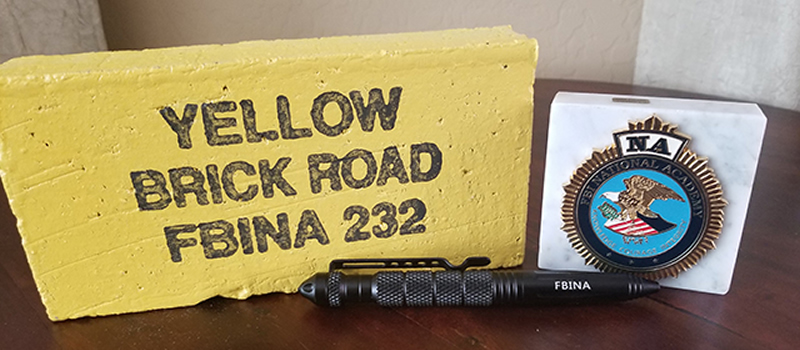
This is a picture of the actual yellow brick Isabella earned (with her session number on it). It also includes a tactical pen from the FBI National Academy store (Isabella also has her main character use that exact kind of tactical pen in THE CIPHER), and it also includes the FBI National Academy crest mounted on marble beside the brick and pen.
I did a metric ton of research. There are tens of thousands of smart readers who love puzzles and codes. I’ve learned they will enjoy brainteasers if you (a) play fair, and (b) make them challenging but not impossible. I also recommend using a variety of puzzles. Some people are mathematical and enjoy codes based on numerical progressions; others are creative and do well with riddles and anagrams; still others are analytical and prefer to deduce the answer through logic. In A KILLER’S GAME, every reader should be able to find a challenge they can relate to and solve.
When researching an unfamiliar setting, I use three techniques, beginning with massive amounts of online searches. This teaches me the basics, so I don’t waste precious time in phase two, conducting interviews and respectfully asking lots of questions. Finally, if your time and budget allow, traveling to the location is extremely helpful.
Tell us something about yourself your fans might not already know.
For those who remember the movie adaptation of Thomas Harris’s The Silence of the Lambs, the film opens with Jodie Foster in a dense Virginia forest, pulling herself up a steep incline with a thick rope. Foster jogs along a wooded trail with various obstacles, then scales a cargo net and jumps over logs.
A few years back, I pulled myself up that same incline using a rope, scaled the same cargo net, and jumped over the same logs. I completed the entire 6.2-mile obstacle course known as “The Yellow Brick Road.”
Those selected to attend the prestigious FBI National Academy for law enforcement executives go through three months of extensive physical and academic training. Attendees can opt to run the famous o-course. If you make it across the finish line, you earn a “yellow brick.” It’s a physical brick painted yellow with your academy session (mine was 232) stenciled on it. I display my yellow brick on my bookshelf as a reminder to persevere, strive, and achieve what I didn’t know I could.
- The Big Thrill Recommends: ONE BIG HAPPY FAMILY by Jamie Day - September 16, 2024
- The Big Thrill Recommends: ONLY ONE SURVIVES (Video) by Hannah Mary McKinnon - July 30, 2024
- The Big Thrill Recommends: WHAT YOU LEAVE BEHIND by Wanda M. Morris - June 27, 2024

